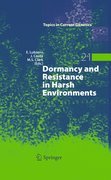
Dormancy and resistance in harsh environments
Lubzens, Esther
Cerda, Joan
Clark, Melody
Many organisms have evolved the ability to enter into and revive from a dormant state. They can survive for long periods in this state (often even months to years), yet can become responsive again within minutes or hours. This is often, but not necessarily, associated with desiccation. Preserving one’s body and reviving it in future generations is a dream of mankind. To date, however, we have failed to learn how cells, tissues or entire organisms can be made dormant or be effectively revived at ambient temperatures. In this book studies onorganisms, ranging from aquatic cyanobacteria that produce akinetes to hibernating mammals, are presented, and reveal common but also divergent physiological and molecular pathways for surviving in a dormant form or for tolerating harsh environments. Attempting to learn the functions associated with dormancy and how they are regulated is one of the great future challenges. Its relevanceto the preservation of cells and tissues is one of the key concerns of this book. A new volume in the series First book to extensively cover the topic of dormancy in cells and organisms Written by experts in the field INDICE: Introduction.- Cyanobacteria.- Yeast.- Plants seeds.- Plant buds.-LEA proteins.- Rotifer resting eggs.- Tartigrades.- Arctic Insects.- Artemia cysts.- Daphnia resting eggs.- Killifish.- Hibernation.- Medical Applications.- Conclusions.-
- ISBN: 978-3-642-12421-1
- Editorial: Springer
- Encuadernacion: Cartoné
- Páginas: 300
- Fecha Publicación: 01/08/2010
- Nº Volúmenes: 1
- Idioma: Inglés
